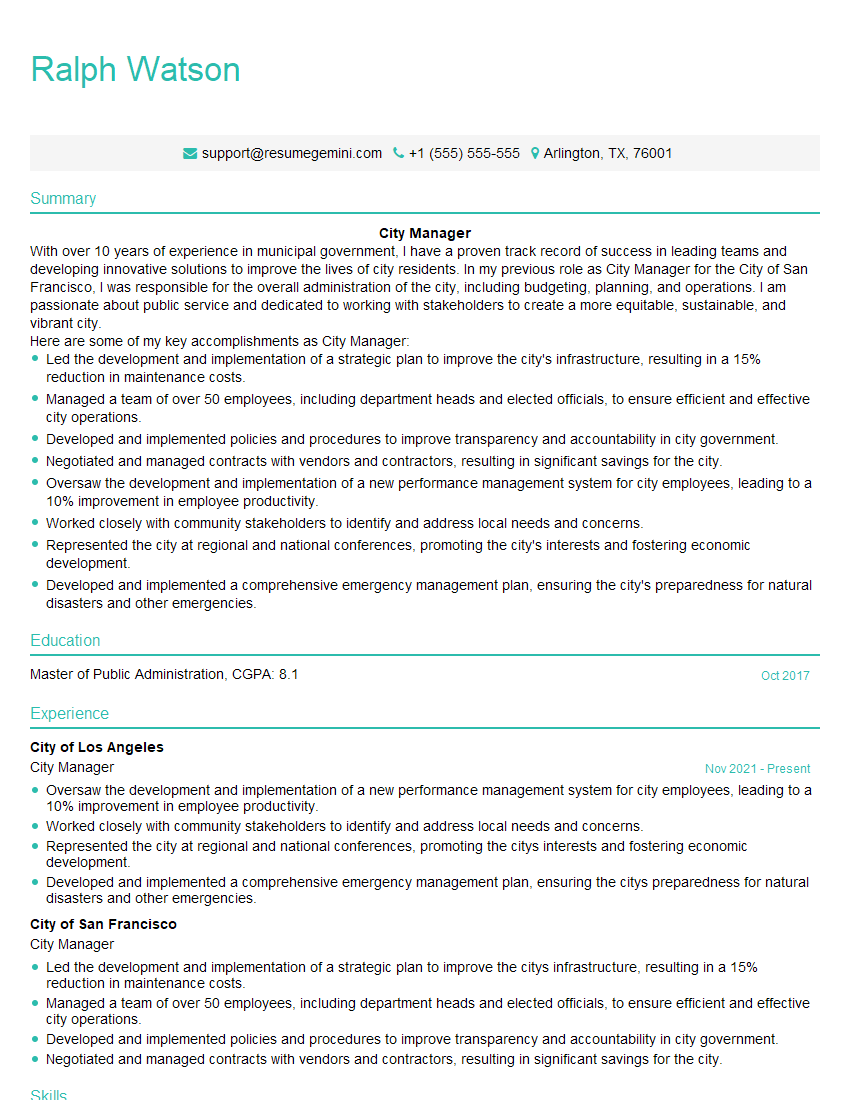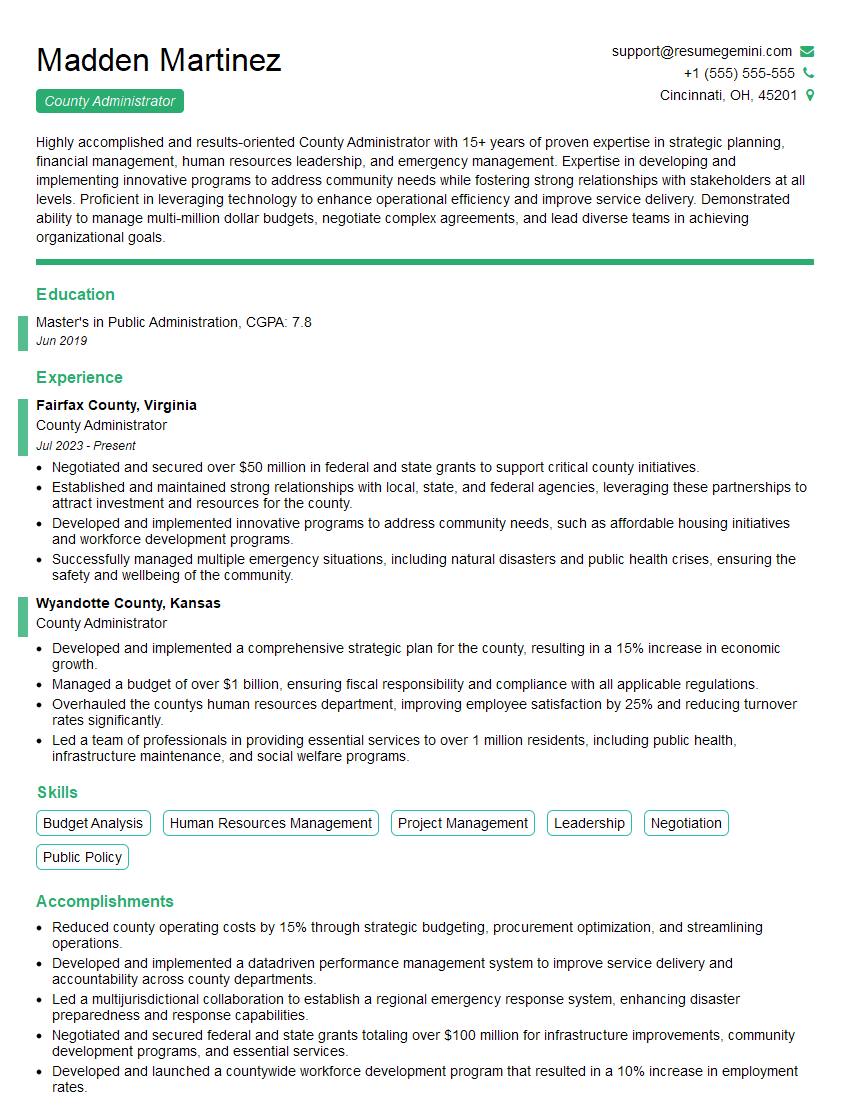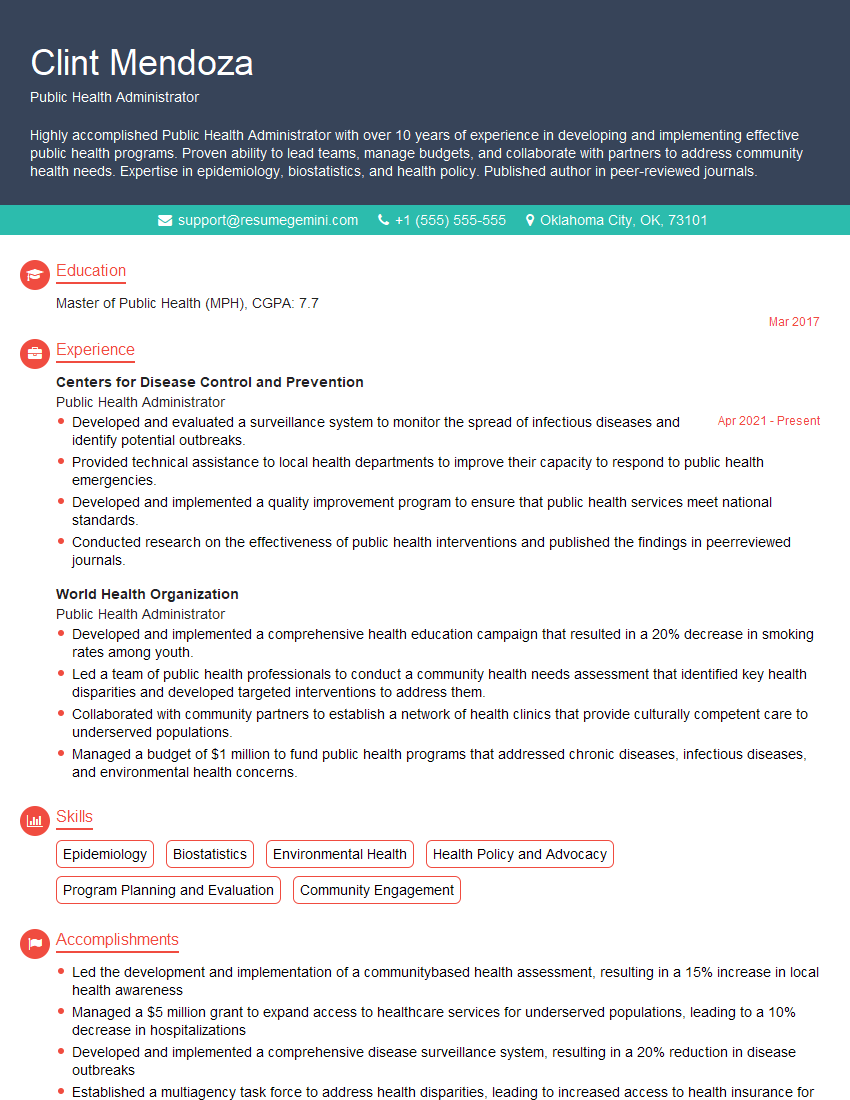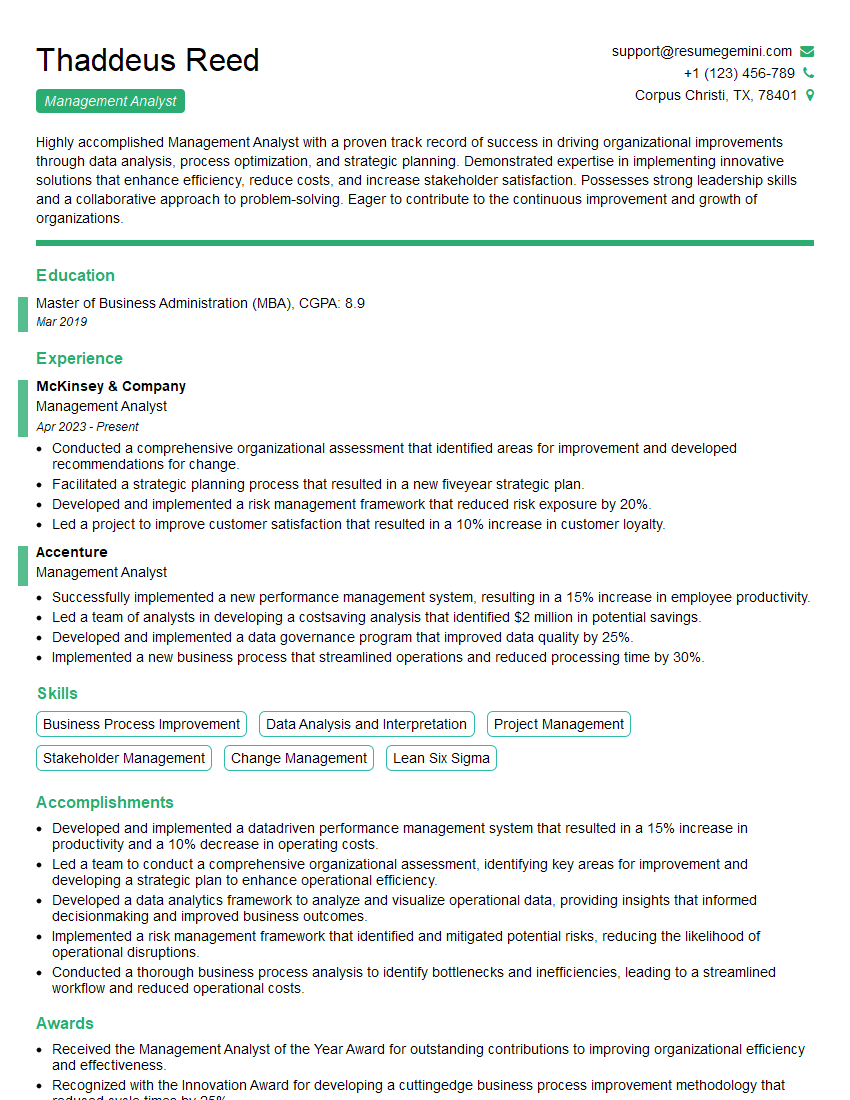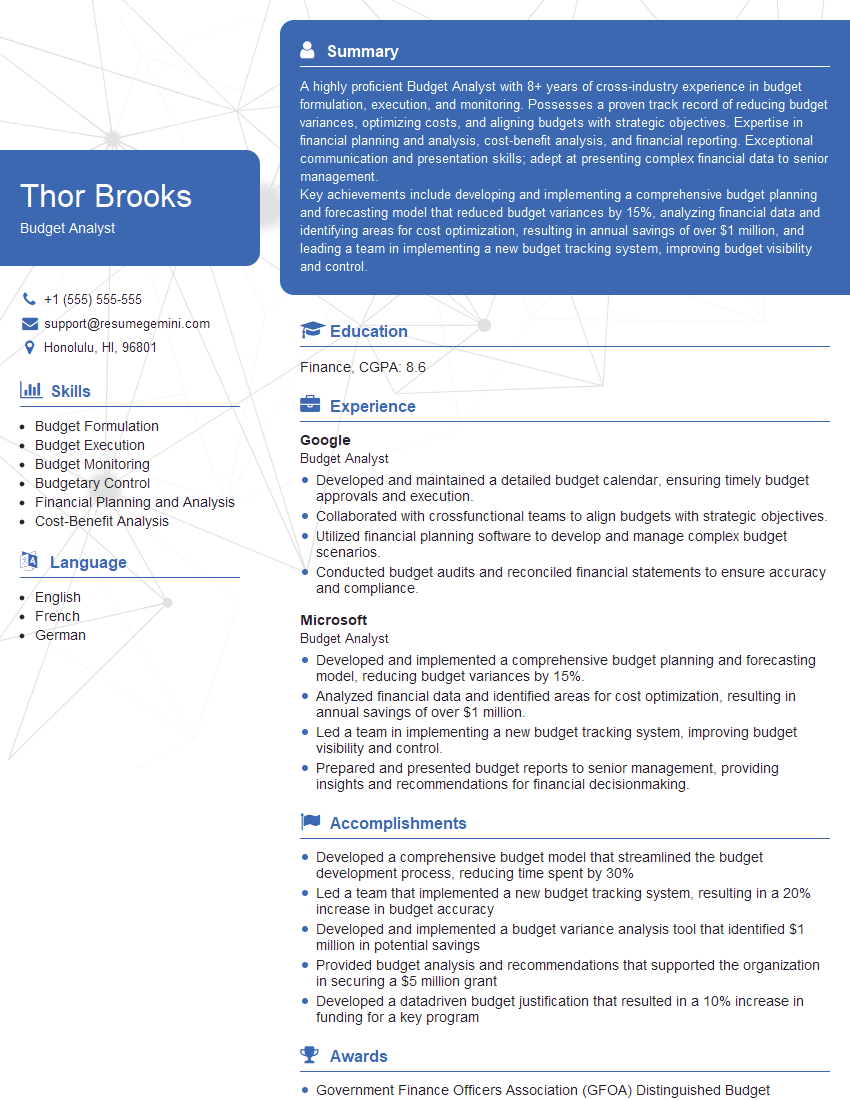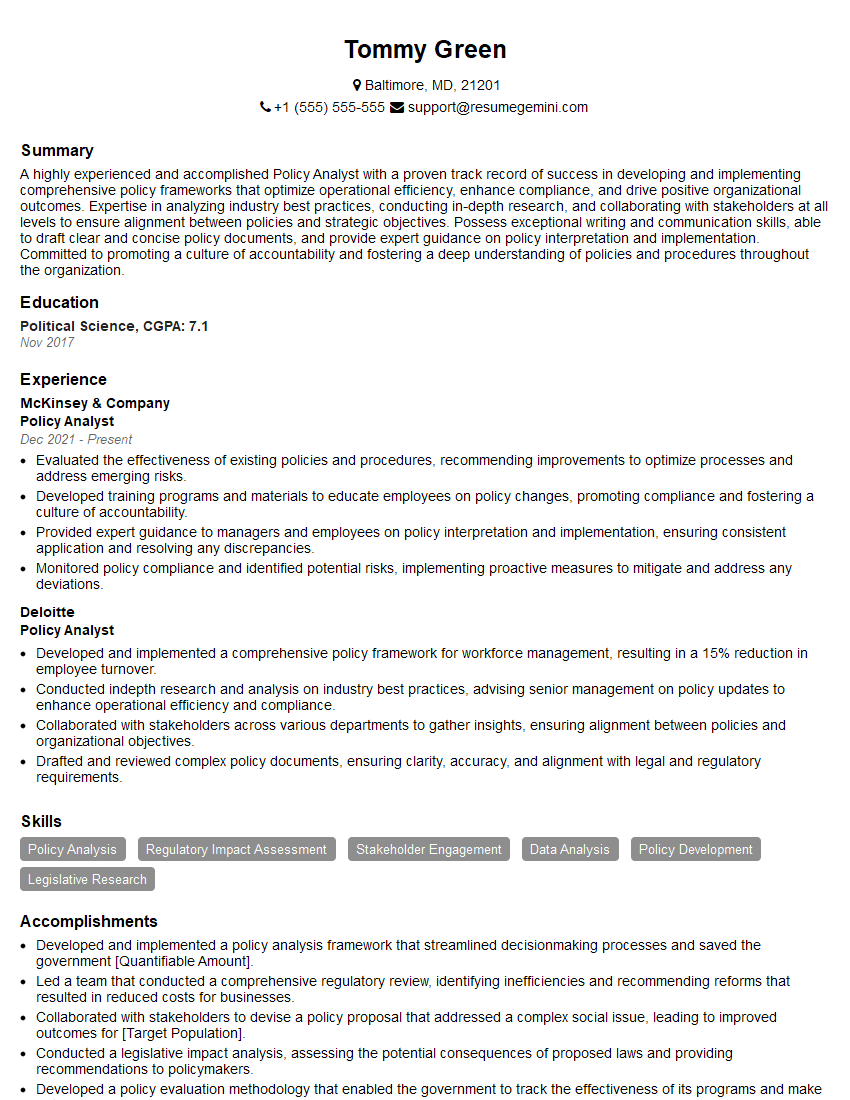Are you ready to stand out in your next interview? Understanding and preparing for Public Administration and Governance interview questions is a game-changer. In this blog, we’ve compiled key questions and expert advice to help you showcase your skills with confidence and precision. Let’s get started on your journey to acing the interview.
Questions Asked in Public Administration and Governance Interview
Q 1. Explain the difference between public administration and public policy.
Public administration and public policy are closely related but distinct concepts. Public policy refers to the what – the course of action a government chooses to pursue to address a societal problem or achieve a specific goal. Think of it as the overall strategy. Public administration, on the other hand, is the how – the implementation and execution of that policy. It’s the process of putting the strategy into action.
Example: Imagine a policy goal of reducing childhood obesity. The public policy might involve initiatives like improving school lunches, increasing access to parks and recreational facilities, and running public awareness campaigns. Public administration would then involve the specific tasks of procuring healthier food for schools, securing funding for park improvements, developing and executing the marketing strategy for campaigns, hiring and managing staff, etc.
Q 2. Describe the New Public Management (NPM) approach and its impact.
The New Public Management (NPM) approach emerged in the late 20th century as a response to perceived inefficiencies in traditional public administration. It emphasizes market-oriented principles within the public sector, aiming to improve efficiency and effectiveness. Key features include:
- Performance measurement and accountability: Focusing on measurable outcomes and holding public officials responsible for results.
- Decentralization and deregulation: Giving more autonomy to individual agencies and reducing bureaucratic red tape.
- Competition and privatization: Introducing competition among service providers and exploring opportunities for private sector involvement.
- Customer focus: Prioritizing the needs and satisfaction of citizens as ‘customers’ of public services.
Impact: NPM has had a significant, albeit mixed, impact. While it has contributed to greater efficiency in some areas and improved accountability in others, critics point to potential drawbacks such as increased inequality, reduced public service quality in some areas, and a greater emphasis on short-term gains over long-term sustainability.
Example: The introduction of performance-related pay for teachers in some countries is an example of NPM’s emphasis on performance measurement. However, this has sometimes been criticized for focusing too much on easily measurable metrics at the expense of broader educational goals.
Q 3. What are the key principles of good governance?
Good governance encompasses several key principles that ensure a government is effective, accountable, and responsive to its citizens. These include:
- Participation: Citizens have a voice in decision-making processes that affect their lives.
- Rule of law: Laws are fair, equally enforced, and applied consistently.
- Transparency: Government processes and decisions are open and accessible to the public.
- Responsiveness: The government is sensitive and responsive to the needs of its citizens.
- Consensus orientation: Seeking to build consensus among different groups and interests.
- Equity and inclusiveness: Ensuring fair treatment and opportunities for all members of society.
- Effectiveness and efficiency: Using resources efficiently and effectively to achieve desired outcomes.
- Accountability: Government officials are held accountable for their actions and decisions.
These principles are interconnected and mutually reinforcing. A government that embraces these principles fosters trust, improves service delivery, and promotes sustainable development.
Q 4. How would you analyze a government budget?
Analyzing a government budget involves a multi-faceted approach that goes beyond simply reviewing the numbers. It requires a thorough understanding of the government’s priorities, its revenue streams, and the efficiency of its spending. My approach would involve the following steps:
- Understanding the context: Examine the economic climate, the government’s strategic goals, and any pressing social or environmental challenges.
- Revenue analysis: Evaluate the sources of government revenue (taxes, fees, grants, etc.) and assess their sustainability and potential for growth.
- Expenditure analysis: Scrutinize spending across different departments and programs. This involves identifying areas of high spending, evaluating the effectiveness of various programs, and comparing spending to previous years and other jurisdictions.
- Program evaluation: Assess the impact and efficiency of specific government programs by examining their outputs, outcomes, and overall value for money.
- Financial sustainability: Evaluate the long-term financial viability of the budget, considering potential risks and uncertainties.
- Transparency and accountability: Assess the budget’s transparency and the accountability mechanisms in place to ensure responsible spending.
This analysis should identify areas for potential improvement, such as cost savings, improved program effectiveness, or reallocation of resources to address critical needs.
Q 5. Explain your understanding of the budget cycle.
The budget cycle is the annual (or sometimes multi-year) process through which a government plans, prepares, approves, implements, and monitors its budget. It typically involves several key stages:
- Preparation: Government agencies submit their budget requests to the relevant ministry or department.
- Review and consolidation: The budget requests are reviewed and consolidated into a single government-wide budget proposal.
- Approval: The budget proposal is submitted to the legislature (parliament or congress) for approval. This often involves detailed scrutiny and debate.
- Implementation: Once approved, the budget is implemented, with funds allocated to different agencies and programs.
- Monitoring and evaluation: The government monitors spending throughout the year and evaluates the performance of different programs against their objectives.
- Auditing: Independent audits ensure that the budget has been properly managed and accounted for.
The budget cycle is crucial for ensuring that government resources are allocated effectively and transparently. Delays or disruptions to the cycle can have significant consequences for public services and the economy.
Q 6. What are the challenges in implementing public policy?
Implementing public policy is often challenging, even with the best intentions. Several factors contribute to these difficulties:
- Political opposition: Policy proposals can face strong opposition from interest groups or political parties, leading to delays or modifications.
- Bureaucratic resistance: Government agencies may resist implementing policies that challenge existing practices or require significant changes.
- Lack of resources: Insufficient funding, personnel, or other resources can hamper the effective implementation of policies.
- Unforeseen circumstances: Unexpected events or changes in the environment can undermine policy implementation.
- Complexity: Complex policies can be difficult to understand and implement effectively.
- Poor coordination: Lack of coordination among different government agencies involved in implementation can lead to inconsistencies and inefficiencies.
- Public resistance: Citizens may resist policies that they perceive as unfair or harmful to their interests.
Successful policy implementation requires careful planning, strong leadership, effective communication, monitoring and evaluation, and adaptability to changing circumstances.
Q 7. How do you measure the effectiveness of a public program?
Measuring the effectiveness of a public program requires a systematic approach that considers both the program’s outputs (what it produces) and its outcomes (the impact it has). Methods for evaluating effectiveness include:
- Quantitative indicators: Measuring things like the number of people served, the cost per unit of service, or changes in relevant social or economic indicators.
- Qualitative indicators: Gathering data through surveys, interviews, or focus groups to assess citizen satisfaction, program impact, and perceived effectiveness.
- Cost-benefit analysis: Evaluating the economic costs and benefits of the program.
- Impact evaluation: Using experimental or quasi-experimental designs to rigorously assess the causal impact of the program.
- Process evaluation: Assessing the efficiency and effectiveness of the program’s implementation process.
It is important to select appropriate indicators based on the specific goals and objectives of the program, and to use a mix of quantitative and qualitative methods to obtain a comprehensive understanding of its effectiveness. Regular monitoring and evaluation are essential for ensuring that programs are achieving their intended outcomes and that adjustments are made as needed.
Q 8. Describe your experience with performance management in the public sector.
Performance management in the public sector focuses on ensuring government agencies and employees efficiently and effectively achieve their goals. It’s a multifaceted process involving setting clear objectives, monitoring progress, providing constructive feedback, and ultimately evaluating outcomes. My experience includes developing and implementing performance frameworks aligned with strategic plans, utilizing key performance indicators (KPIs) to track progress, and conducting regular performance reviews. For example, in my previous role at the Department of Transportation, we implemented a new performance management system focused on reducing traffic congestion. This involved setting specific, measurable, achievable, relevant, and time-bound (SMART) goals, tracking metrics like average commute times and incident response rates, and providing regular feedback to teams responsible for different aspects of traffic management. The results demonstrated a significant improvement in traffic flow within the first year, showcasing the effectiveness of our performance management approach.
I also have experience in using performance data to inform resource allocation, demonstrating the link between performance and budget decisions. This involved analyzing performance data across various departments to identify areas requiring additional support or resources and justifying those requests based on quantifiable results. This is critical for maximizing public funds and ensuring efficient service delivery.
Q 9. How would you handle ethical dilemmas in public service?
Ethical dilemmas are unavoidable in public service, where decisions often impact numerous stakeholders and involve significant public interest. My approach is guided by a strong ethical framework grounded in transparency, accountability, and the public good. I would systematically analyze a dilemma using a structured approach:
- Identify the ethical issue: Clearly define the conflict of interest or ethical challenge.
- Gather relevant information: Obtain all pertinent facts and perspectives from involved parties.
- Identify stakeholders: Determine who will be affected by the decision.
- Consider applicable laws, regulations, and ethical codes: Refer to relevant codes of conduct and legal frameworks.
- Evaluate potential solutions: Weigh the pros and cons of each option considering its impact on stakeholders and alignment with ethical principles.
- Document the decision-making process: Maintain a transparent record of the situation, the considerations, and the chosen course of action.
- Seek advice and counsel: Consult with ethical advisors or mentors if needed, ensuring objectivity and adherence to the best practices of the organization.
For example, if faced with pressure to award a contract to a company with political connections despite a more qualified competitor existing, I would meticulously document my evaluation of both bids, highlighting the reasons for choosing the more qualified candidate. This transparency protects me from potential accusations of favoritism and maintains public trust.
Q 10. Explain the importance of transparency and accountability in government.
Transparency and accountability are cornerstones of good governance. Transparency ensures that government actions are open and accessible to the public, fostering trust and allowing citizens to hold their representatives accountable. Accountability means that government officials are responsible for their actions and decisions, and there are mechanisms in place to address misconduct or inefficiency. These two principles work together to ensure the responsible and effective use of public resources and promote public confidence in government institutions.
Transparency manifests in readily available information on government budgets, spending, policies, and decision-making processes. Accountability involves mechanisms such as audits, independent oversight bodies, and accessible channels for public complaints and redress. Consider the example of an open data initiative, where government data is made freely available to the public. This promotes transparency by allowing citizens to analyze government spending, identify inefficiencies, and hold officials accountable for their use of public resources. Conversely, a lack of transparency and accountability can lead to corruption, inefficiency, and erosion of public trust, ultimately undermining the legitimacy of the government.
Q 11. What is your understanding of regulatory capture?
Regulatory capture occurs when a regulatory agency, created to act in the public interest, instead advances the commercial or political interests of the industry it is supposed to regulate. This happens when regulated entities exert undue influence on the agency, leading to biased regulations that favor the industry rather than the public. This can manifest in various ways, such as agencies adopting industry-friendly regulations, failing to enforce regulations effectively, or even actively promoting the interests of the regulated industry.
One example is when a telecommunications regulatory agency becomes heavily influenced by large telecom companies. This could result in regulations that stifle competition, protect incumbents, and ultimately harm consumers through higher prices and limited choices. To mitigate regulatory capture, measures like increased transparency, independent oversight, and rotating agency personnel can be effective.
Q 12. How would you address stakeholder conflicts in a public project?
Addressing stakeholder conflicts in public projects requires a collaborative and inclusive approach. My strategy would involve:
- Identifying all stakeholders: This includes individuals, groups, and organizations affected by or involved in the project.
- Understanding their interests and concerns: Conducting thorough stakeholder analysis through surveys, interviews, and public forums to understand their perspectives.
- Facilitating communication and dialogue: Creating a platform for open and transparent communication among stakeholders, encouraging mutual understanding and finding common ground.
- Negotiation and mediation: Employing negotiation skills and possibly involving external mediators to find mutually acceptable solutions.
- Developing a collaborative decision-making process: Involving stakeholders in the decision-making process, ensuring they have a voice in shaping the project’s direction.
- Implementing conflict resolution mechanisms: Establishing clear processes for addressing conflicts that may arise during project implementation.
For instance, in a project involving a new highway, stakeholders might include residents affected by construction, environmental groups concerned about habitat disruption, and businesses anticipating economic benefits. By engaging with all stakeholders through open forums and incorporating their feedback into the design and implementation, a more sustainable and equitable solution could be achieved.
Q 13. Describe your experience with grant writing or management.
My experience with grant writing and management encompasses identifying funding opportunities, developing compelling proposals, and managing awarded grants to ensure successful project completion. This includes writing persuasive proposals that clearly articulate project goals, methodology, and anticipated impact, adhering to funder guidelines, and demonstrating budget feasibility.
In one instance, I successfully secured a substantial grant from the National Science Foundation for a research project on improving public transportation efficiency. This involved a detailed understanding of the NSF’s priorities, crafting a proposal that showcased our team’s expertise and the project’s potential impact, and meticulously managing the budget and reporting requirements throughout the project lifecycle. Furthermore, I’ve managed grants from various sources, including private foundations and governmental agencies, consistently demonstrating a strong understanding of grant management best practices. This includes rigorous financial tracking, timely reporting, and compliance with all grant-related regulations.
Q 14. What are the challenges of working in a highly regulated environment?
Working in a highly regulated environment presents unique challenges, including increased administrative burden, higher compliance costs, and potential for bureaucratic delays. The sheer volume of regulations can be overwhelming, requiring specialized knowledge and expertise to navigate the complex legal and regulatory landscape. Compliance necessitates meticulous documentation, adherence to specific procedures, and ongoing monitoring to avoid penalties or sanctions.
For example, working in the healthcare sector requires strict adherence to HIPAA regulations regarding patient data privacy. Non-compliance can result in severe financial penalties and reputational damage. Another challenge is the potential for regulatory uncertainty, where changes in regulations can necessitate significant adjustments in operations and strategies. This highlights the importance of proactive monitoring of regulatory changes and adaptive capacity to navigate the evolving regulatory landscape.
Q 15. How do you stay informed about current events in public administration?
Staying informed in the dynamic field of public administration requires a multi-faceted approach. I regularly engage with a variety of sources to ensure I have a comprehensive understanding of current trends and challenges. This includes subscribing to reputable journals like the Public Administration Review and Journal of Public Administration Research and Theory, following influential think tanks like the Brookings Institution and the Urban Institute, and actively participating in professional organizations such as the American Society for Public Administration (ASPA).
Beyond academic resources, I maintain a keen awareness of current events through reputable news sources like the New York Times, the Wall Street Journal, and the Financial Times, focusing on sections covering government, policy, and social issues. I also leverage online platforms like Twitter and LinkedIn to follow key figures and organizations in the field, participating in relevant discussions and debates. Finally, attending conferences and workshops allows for direct engagement with leading experts and the opportunity to learn about cutting-edge research and best practices.
Career Expert Tips:
- Ace those interviews! Prepare effectively by reviewing the Top 50 Most Common Interview Questions on ResumeGemini.
- Navigate your job search with confidence! Explore a wide range of Career Tips on ResumeGemini. Learn about common challenges and recommendations to overcome them.
- Craft the perfect resume! Master the Art of Resume Writing with ResumeGemini’s guide. Showcase your unique qualifications and achievements effectively.
- Don’t miss out on holiday savings! Build your dream resume with ResumeGemini’s ATS optimized templates.
Q 16. Explain your understanding of evidence-based policy making.
Evidence-based policymaking (EBP) is a crucial approach that prioritizes using the best available research and data to inform policy decisions. It moves beyond intuition and ideology, instead emphasizing a systematic process of identifying a problem, reviewing existing evidence, developing and implementing interventions, and then rigorously evaluating the results. This cyclical approach allows for continuous improvement and adaptation of policies.
A key element of EBP is the careful selection and interpretation of data. This involves understanding different research methodologies, assessing the quality and validity of studies, and synthesizing findings from multiple sources. For instance, a policy aiming to reduce homelessness might draw upon data from longitudinal studies on housing programs, cost-benefit analyses of different intervention strategies, and qualitative research on the experiences of homeless individuals. The goal is to build a robust evidence base that supports the chosen policy and allows for ongoing monitoring and adjustments based on real-world outcomes. Without rigorous data analysis, policies are more likely to be ineffective or even counterproductive.
Q 17. Describe your experience with data analysis in the public sector.
My experience with data analysis in the public sector spans several projects. In my previous role at [Previous Organization Name], I utilized statistical software like R and SPSS to analyze demographic data to inform the allocation of resources for social services. We identified significant disparities in access to healthcare based on geographic location and socioeconomic status, leading to targeted interventions to address these inequalities. This involved cleaning and manipulating large datasets, performing statistical tests to identify significant trends, and visualizing the findings in clear and accessible formats for policymakers.
Another project involved using Geographic Information Systems (GIS) to map crime rates across a city. By analyzing spatial data alongside socioeconomic indicators, we were able to identify high-risk areas and tailor crime prevention strategies accordingly. This involved not just technical analysis, but also working closely with stakeholders – law enforcement, community groups – to ensure the data was interpreted and used effectively. The success of these projects highlights the importance of both technical skills in data analysis and strong communication skills in translating complex findings for non-technical audiences.
Q 18. How would you improve public engagement and participation in government?
Improving public engagement and participation requires a multifaceted approach that prioritizes accessibility, transparency, and inclusivity. This goes beyond simply holding town hall meetings; it’s about creating multiple avenues for citizen input and ensuring diverse voices are heard.
- Enhance Online Participation: Develop user-friendly online platforms that allow citizens to easily access government information, submit feedback, and participate in online surveys and consultations.
- Utilize Social Media: Employ social media platforms to reach a broader audience, including younger demographics, and engage in two-way conversations.
- Promote Deliberative Processes: Organize citizen assemblies, forums, and participatory budgeting processes that facilitate informed discussion and collaborative decision-making.
- Invest in Community Outreach: Engage directly with communities through local events and initiatives, ensuring that outreach efforts are tailored to specific demographics and communication preferences.
- Improve Data Transparency: Make government data easily accessible and understandable to the public, empowering citizens to participate in evidence-based discussions.
Crucially, success hinges on active listening and genuine responsiveness to citizen feedback. Government agencies need to show a commitment to acting upon the input received, demonstrating the value of citizen participation in shaping public policy.
Q 19. What are some common challenges in public sector human resource management?
Public sector human resource management faces unique challenges stemming from its public accountability, diverse workforce, and often-complex bureaucratic structures. Some key challenges include:
- Attracting and Retaining Talent: Competition with the private sector for skilled professionals can be fierce, especially for roles requiring specialized expertise. Public sector compensation and benefits packages may not always be competitive.
- Managing a Diverse Workforce: The public sector employs individuals from a wide range of backgrounds and experiences. Effective HR management requires strategies to foster inclusion, address potential biases, and ensure equal opportunities for all employees.
- Navigating Bureaucracy: Complex rules, regulations, and procedures can sometimes hinder efficiency and flexibility in HR practices. Streamlining processes and leveraging technology can help mitigate this.
- Ensuring Accountability and Transparency: Public sector HR practices are subject to higher levels of scrutiny and accountability. Transparency and adherence to ethical standards are paramount.
- Addressing Workforce Development Needs: Ongoing training and development programs are crucial for upskilling the workforce and preparing employees for the evolving needs of the public sector.
Effective HR management in the public sector requires a strategic approach that balances efficiency, equity, and accountability.
Q 20. How would you manage a crisis situation in a government agency?
Managing a crisis situation in a government agency requires a swift, decisive, and transparent response. My approach would be guided by a structured framework:
- Assessment and Activation: Immediately assess the nature and scope of the crisis, activating the relevant emergency response plan and communication protocols.
- Communication and Transparency: Establish clear and consistent communication channels with the public, media, and internal stakeholders. Transparency is crucial to build public trust and mitigate misinformation.
- Coordination and Collaboration: Coordinate effectively with other government agencies, emergency services, and community partners. Collaboration is essential for a comprehensive and effective response.
- Resource Allocation: Allocate resources – personnel, funding, equipment – strategically to address the most pressing needs.
- Mitigation and Recovery: Implement measures to mitigate the immediate impact of the crisis and develop a plan for long-term recovery and prevention of future occurrences.
- Post-Crisis Evaluation: Conduct a thorough review of the agency’s response to identify areas for improvement in future crisis management.
A real-world example would be a natural disaster. Rapid assessment of damage, efficient resource allocation for emergency relief, clear communication about evacuation plans, and transparent updates on recovery efforts are all critical elements. The post-crisis evaluation helps to refine disaster preparedness plans and improve the resilience of the agency.
Q 21. Explain your understanding of strategic planning in the public sector.
Strategic planning in the public sector is a crucial process that involves defining long-term goals, identifying key priorities, and developing action plans to achieve desired outcomes. Unlike private sector strategic planning that often focuses primarily on profit maximization, public sector planning considers broader societal goals and values such as equity, sustainability, and public service.
The process typically includes several key steps:
- Environmental Scanning: Analyzing internal and external factors influencing the agency’s ability to achieve its objectives (e.g., political climate, economic conditions, social trends, technological advancements).
- Goal Setting: Defining clear and measurable goals aligned with the agency’s mission and broader public policy objectives.
- Resource Allocation: Determining how resources – financial, human, and technological – will be allocated to support the achievement of strategic goals.
- Implementation and Monitoring: Developing action plans, timelines, and performance indicators to track progress and make necessary adjustments.
- Evaluation: Assessing the effectiveness of the strategic plan in achieving its goals and making necessary revisions for future cycles.
A well-developed strategic plan provides a roadmap for the agency’s activities, ensuring that its efforts are focused and aligned with its overall mission. It also aids in resource allocation, enhances accountability, and improves coordination within the agency and across different departments.
Q 22. How would you use technology to improve government services?
Technology can revolutionize government services, making them more efficient, accessible, and citizen-centric. This involves leveraging various technologies in a strategic and integrated manner.
- Online Portals and Citizen Applications: Creating user-friendly online portals allows citizens to access services like applying for licenses, paying taxes, or reporting issues 24/7, eliminating the need for physical visits. Imagine a streamlined application for a driver’s license, completed entirely online with digital document uploads and verification.
- Data Analytics and Predictive Modeling: Analyzing large datasets can help governments anticipate needs and allocate resources more effectively. For example, predicting traffic congestion patterns can optimize traffic light timing, improving commutes and reducing emissions.
Predictive model: Y = β0 + β1X1 + β2X2 + ... + ε(where Y is the predicted outcome, X’s are predictor variables, and ε is the error term). - Artificial Intelligence (AI) and Automation: AI-powered chatbots can handle routine inquiries, freeing up human agents to focus on complex issues. Automated systems can process applications and payments faster and with fewer errors. Think of AI assisting in welfare eligibility determination, speeding up the process while minimizing administrative errors.
- Blockchain Technology: Ensuring data security and transparency is critical. Blockchain can improve data integrity in areas like land registries or voting systems, making them tamper-proof and verifiable.
- Open Data Initiatives: Making government data publicly accessible fosters transparency and accountability, enabling citizens and researchers to track government performance and identify areas for improvement. For instance, publishing crime statistics in real-time allows communities to see where resources are needed most.
Successful implementation requires careful planning, robust cybersecurity measures, and ongoing training for government employees to effectively utilize these technologies.
Q 23. What are some examples of successful public-private partnerships?
Public-private partnerships (PPPs) combine the resources and expertise of both the public and private sectors to deliver public services. Successful partnerships require careful planning, clear agreements, and strong communication.
- Infrastructure Projects: PPPs are often used for large-scale infrastructure projects like highways, hospitals, or schools. The private sector contributes financing and expertise in construction and management, while the public sector provides land and regulatory oversight. A successful example is the development of certain toll roads, where private companies build and operate the roads in exchange for toll revenue over a specified period.
- Technology Procurement: PPPs can be effective in procuring and implementing complex technology systems. A private sector firm might develop a new software system for government agencies, sharing the risk and cost with the government. Imagine a partnership to develop a sophisticated online tax filing system, combining the private sector’s technology expertise with the government’s policy knowledge.
- Service Delivery: PPPs can be used to improve the delivery of public services. For instance, a private company might manage a public park, ensuring its upkeep and maintenance. An example might be a private company managing waste collection and recycling services in a city, improving efficiency and reducing costs.
The success of a PPP hinges on a well-defined contract that clearly outlines the roles, responsibilities, and risk-sharing mechanisms between the partners. Careful selection of the private sector partner and ongoing monitoring are also essential.
Q 24. What are the different types of government procurement methods?
Government procurement methods vary, aiming for transparency, fairness, and value for money. The choice of method depends on factors like the complexity of the procurement, the value of the contract, and the urgency of the need.
- Open Tendering: This is a competitive process where any qualified supplier can submit a bid. This ensures a wide range of options and promotes price competition.
- Restricted Tendering: This involves inviting bids from a pre-selected list of suppliers, often due to specialized requirements or prior experience. This approach can be more efficient but risks limiting competition.
- Negotiated Procurement: This involves negotiating a contract directly with a supplier, often used when the requirements are complex or require unique expertise. While flexible, it requires careful management to avoid bias or favoritism.
- Framework Agreements: This is a long-term agreement with multiple suppliers, providing a pre-approved list of suppliers for various goods or services. This streamlines procurement for recurring needs but requires careful management of supplier performance.
- Direct Contracting: This involves awarding a contract to a single supplier without a competitive process. This is typically used for emergency situations or when only one supplier can meet the specific requirements. However, this should be used sparingly and with transparency to avoid potential conflicts of interest.
Effective procurement management involves robust contract management, performance monitoring, and mechanisms for dispute resolution.
Q 25. How would you evaluate the effectiveness of a government regulation?
Evaluating the effectiveness of a government regulation requires a multifaceted approach that considers its intended goals, actual impact, and unintended consequences.
- Define Clear Objectives: Start by clearly defining the regulation’s intended outcomes. What problem is it trying to solve? What are the measurable goals?
- Measure the Impact: Develop metrics to measure the regulation’s impact on both the target issue and related sectors. For instance, if the regulation aims to reduce pollution, you might track emissions levels, air quality, and related health outcomes.
- Assess Cost-Effectiveness: Compare the benefits of the regulation to its costs. This involves assessing both direct costs (e.g., enforcement costs) and indirect costs (e.g., compliance costs for businesses).
- Analyze Unintended Consequences: Identify any unintended negative impacts of the regulation. For instance, a regulation intended to protect the environment might inadvertently harm a specific industry.
- Gather Stakeholder Feedback: Collect data from different stakeholders – businesses, citizens, affected groups – to gather diverse perspectives on the regulation’s effectiveness.
This evaluation should be ongoing, allowing for adjustments and improvements to the regulation over time based on data and feedback. Regular reviews and data analysis are vital for identifying areas where improvements are needed.
Q 26. Explain your understanding of risk management in public administration.
Risk management in public administration is a systematic process for identifying, assessing, and mitigating risks that could affect the achievement of organizational goals. It’s crucial for ensuring the effectiveness, efficiency, and accountability of government operations.
- Risk Identification: This involves systematically identifying potential risks across various areas, such as financial risks, operational risks, reputational risks, and legal risks. For instance, identifying potential budget shortfalls, cybersecurity vulnerabilities, or public health emergencies.
- Risk Assessment: This involves analyzing the likelihood and potential impact of each identified risk. This assessment informs prioritization of which risks to address first.
- Risk Mitigation: This involves developing and implementing strategies to reduce or eliminate the likelihood or impact of identified risks. This might involve developing contingency plans, investing in cybersecurity measures, or establishing clear protocols for handling emergencies.
- Risk Monitoring and Review: This involves regularly monitoring the effectiveness of risk mitigation strategies and updating the risk assessment as needed. This is an iterative process, requiring constant vigilance and adaptation.
A robust risk management framework enhances the organization’s resilience and its ability to respond effectively to unforeseen challenges, protecting public resources and ensuring the continued delivery of essential services. Think of disaster preparedness plans as a clear example of risk management in action.
Q 27. How do you prioritize competing demands and limited resources?
Prioritizing competing demands and limited resources requires a structured approach that balances competing interests and maximizes the impact of available funds.
- Establish Clear Priorities: Begin by defining clear organizational goals and objectives. This provides a framework for evaluating the importance of different demands.
- Resource Allocation Framework: Develop a framework for allocating resources based on established priorities. This might involve using cost-benefit analysis, impact assessments, or other quantitative methods.
- Stakeholder Engagement: Involve relevant stakeholders in the prioritization process to ensure diverse perspectives are considered and buy-in is achieved.
- Transparency and Accountability: Maintain transparency in the decision-making process and demonstrate accountability for resource allocation decisions.
- Adaptive Management: Regularly review and adjust priorities based on new information, changing circumstances, or feedback from stakeholders.
Effective prioritization involves making difficult choices and sometimes saying ‘no’ to certain demands to ensure resources are focused on the most critical needs. Think of it like a triage system in a hospital emergency room – prioritizing the most urgent cases first.
Q 28. Describe your experience with policy development and implementation.
My experience in policy development and implementation spans several areas, encompassing research, stakeholder consultation, drafting, and evaluation. I’ve worked on policies related to environmental protection, economic development, and social welfare. I’ll use an example to illustrate my approach.
In a recent project focusing on improving access to healthcare in underserved communities, I was involved in the following steps:
- Needs Assessment and Research: We conducted extensive research to identify the specific challenges faced by these communities, analyzing existing data and conducting interviews with community members and healthcare providers.
- Stakeholder Consultation: We engaged with various stakeholders including government agencies, healthcare providers, community leaders, and residents to gather their input and ensure that the policy addressed their concerns.
- Policy Drafting and Review: Based on our research and stakeholder consultations, we drafted a policy proposal that included specific strategies and recommendations for addressing the identified challenges. The draft was reviewed by multiple stakeholders to ensure its effectiveness and feasibility.
- Policy Implementation and Monitoring: After the policy was approved, we worked with implementing agencies to ensure its effective implementation. We established mechanisms for monitoring and evaluation to track progress and make necessary adjustments.
- Evaluation and Adjustment: We conducted regular evaluations to assess the policy’s effectiveness and make adjustments as needed. This iterative process ensures that the policy remains relevant and responsive to changing needs.
Throughout this process, I emphasized collaboration, data-driven decision-making, and a commitment to ensuring the policy effectively served the intended population.
Key Topics to Learn for Public Administration and Governance Interview
- Public Policy Analysis: Understand the policy cycle, from agenda-setting to evaluation. Explore different policy instruments and their effectiveness. Consider the role of evidence-based policy making.
- Governance Structures & Models: Familiarize yourself with different governmental structures (e.g., parliamentary, presidential) and their implications for policy implementation. Analyze the strengths and weaknesses of various governance models.
- Public Budgeting & Finance: Grasp the principles of public budgeting, including revenue generation, expenditure control, and fiscal responsibility. Understand different budgeting models and their impact on public services.
- Organizational Behavior & Management in the Public Sector: Explore leadership styles, team dynamics, and change management within public organizations. Analyze the unique challenges of managing public sector employees and resources.
- Ethics and Accountability in Public Administration: Understand the importance of ethical conduct and transparency in government. Explore mechanisms for accountability and oversight, including audits and investigations.
- Public Service Delivery & Performance Management: Analyze the challenges of delivering effective public services and evaluate different performance measurement tools. Consider the impact of technology and innovation on service delivery.
- Comparative Public Administration: Explore similarities and differences in public administration across different countries and contexts. This broadens your perspective and demonstrates a deeper understanding of the field.
- Strategic Planning and Program Evaluation: Understand how to develop and implement strategic plans for public organizations. Learn to evaluate the effectiveness and impact of public programs.
Next Steps
Mastering Public Administration and Governance opens doors to impactful careers shaping our communities and improving lives. A strong understanding of these principles is vital for success in interviews and throughout your career. To maximize your job prospects, invest in crafting an ATS-friendly resume that highlights your skills and experience effectively. ResumeGemini is a trusted resource to help you build a professional and impactful resume tailored to the public sector. Examples of resumes tailored to Public Administration and Governance are available to further guide your efforts. Take the next step toward your dream career today!
Explore more articles
Users Rating of Our Blogs
Share Your Experience
We value your feedback! Please rate our content and share your thoughts (optional).
What Readers Say About Our Blog
This was kind of a unique content I found around the specialized skills. Very helpful questions and good detailed answers.
Very Helpful blog, thank you Interviewgemini team.
